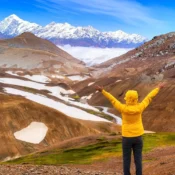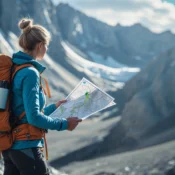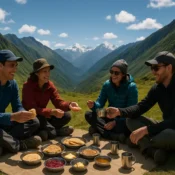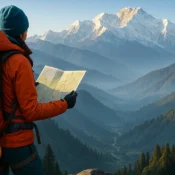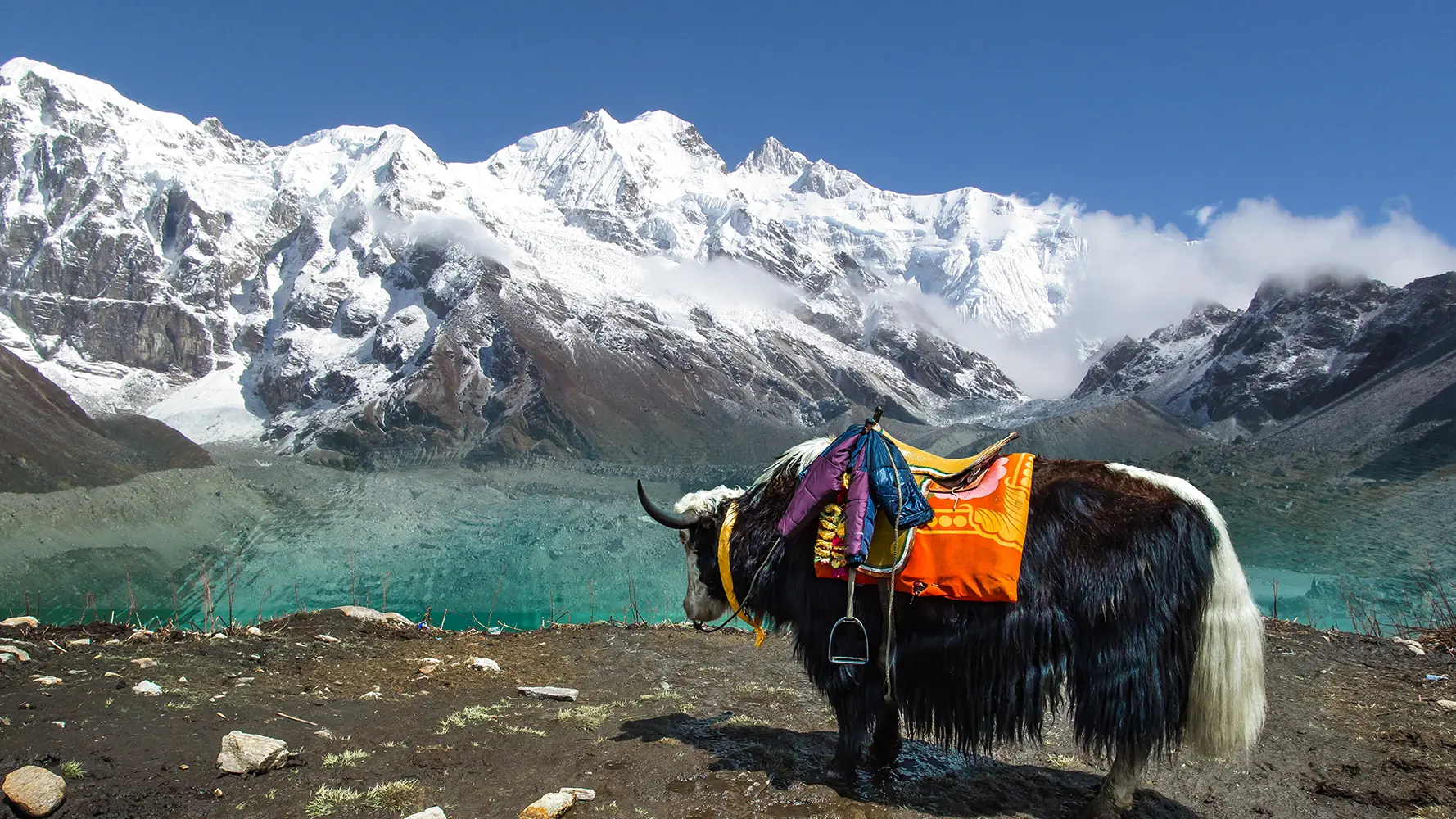
About Sikkim
Situated at the lap of the Eastern Himalayas, Sikkim stands as India’s most enchanting mountain state. This tiny gem borders Nepal, Bhutan, and Tibet, creating a unique cultural melting pot that captivates every visitor. With just 7,096 square kilometers, Sikkim packs incredible diversity into its compact territory.
Adventure seekers flock here for world-class trekking routes. The famous Goecha La trek offers stunning views of Kanchenjunga, the world’s third-highest peak. Mountain biking enthusiasts tackle challenging trails through pristine forests. Meanwhile, spiritual travelers find peace in ancient monasteries like Rumtek and Pemayangtse.
The state’s capital, Gangtok, buzzes with energy. Modern cafes sit alongside traditional markets. Cable cars whisk visitors to panoramic viewpoints. The famous MG Marg pedestrian zone comes alive each evening with locals and tourists alike.
Nature lovers discover incredible biodiversity here. Sikkim hosts over 4,000 flowering plant species. Rare orchids bloom in protected valleys. The state proudly maintains its status as India’s first fully organic region. Crystal-clear lakes like Tsomgo and Gurudongmar reflect snow-capped peaks perfectly.
Cultural richness defines everyday life. Buddhist prayer flags flutter in mountain breezes. Hindu temples share neighborhoods with monasteries. Local festivals celebrate harvests and seasons with colorful dances.
Food enthusiasts savor unique Sikkimese cuisine. Momos, thukpa, and gundruk offer authentic mountain flavors. Local markets sell fresh yak cheese and traditional fermented vegetables.
Whether seeking adventure, spirituality, or natural beauty, Sikkim delivers unforgettable experiences. This Himalayan paradise welcomes travelers year-round, each season revealing new wonders.
Quick Facts About Sikkim
| Capital: | Gangtok |
| Current Chief Minister: | Prem Singh Tamang (P.S. Golay) – Since May 2019 |
| Population (2025): | Approximately 7.01 lakh (701,070 people) |
| Total Districts: | 6 (Gangtok, Namchi, Mangan, Gyalshing, Pakyong, Soreng) |
| Area: | 7,096 square kilometers |
| Official Languages: | English, Nepali, Sikkimese (Bhutia), Lepcha |
| Statehood: | May 16, 1975 (50th anniversary in 2025) |
Sikkim History
Sikkim’s history reads like an epic tale spanning centuries. The land was originally inhabited by two indigenous communities who coexisted harmoniously: the Lepchas, known as the “Rong” people, and the Limbus (also called “Tsongs”), both considered the original autochthonous inhabitants of this mystical landscape.
The Lepchas primarily occupied the central and eastern regions, while the Limbus inhabited the western parts of Greater Sikkim (present-day Limbuwan region). These indigenous communities lived in perfect harmony with nature, with Lepchas practicing Bonism and Munism, and Limbus following Yumaism or Yuma Sammang (a form of Kirat Mundhum) – ancient animistic faiths that viewed mountains, lakes, and forests as sacred entities.
The name “Sikkim” itself comes from the Limbu words “Su Him,” meaning “new house,” reflecting the state’s role as a welcoming haven for diverse communities throughout history.
The Rise of the Buddhist Kingdom
In the 13th century, Guru Tashi, a prince from Eastern Tibet’s Minyak House, received a divine vision instructing him to travel south. This led to the establishment of Buddhist influence in the region. The pivotal moment came in 1642 when Phuntsog Namgyal was consecrated as the first Chogyal (priest-king) at Norbugang in Yuksom, marking the birth of the Kingdom of Sikkim.
The Namgyal dynasty ruled Sikkim for over 300 years, creating a unique Buddhist kingdom that became a sanctuary for Tibetan culture and traditions. The Chogyals were not just rulers but spiritual leaders who guided their people with wisdom and compassion.
The British Era and Modern Transformation
The 18th and 19th centuries brought notable changes. After supporting the British in the Anglo-Nepalese War (1814-1816), Sikkim became a British protectorate in 1890. This period saw the loss of Darjeeling to the British but also brought stability and development.
Following India’s independence in 1947, Sikkim signed the Indo-Sikkimese Treaty of 1950, becoming a protectorate under Indian guidance while maintaining internal autonomy. The final chapter of this royal saga concluded on May 16, 1975, when Sikkim peacefully merged with India, becoming its 22nd state under Prime Minister Indira Gandhi.
Culture of Sikkim
Sikkim’s culture forms a beautiful garden because of four main ethnic groups: Lepchas (the indigenous “Rong” people), Limbus or Tsongs (the other indigenous autochthonous community), Bhutias ( and Nepalese. This cultural diversity has created a unique Sikkimese identity that embraces differences while maintaining unity.
Religious Diversity and Distinct Faith Traditions of Sikkim
Sikkim showcases remarkable religious diversity, where each community maintains its distinct spiritual practices while coexisting harmoniously. Unlike a simple religious breakdown by percentages, each ethnic group follows their own traditional faith systems:
Lepcha Religious Practices:
- Munism and Bonism – Ancient animistic faith systems
- Nature worship – Mountains, rivers, forests, and rocks are considered sacred
- Mun and Bongthing – Traditional priests who perform sacred rituals
- Chief Goddess: Nozyongnyu and Mother-creator It Bumoo (Itbu-moo)
- While some have adopted Buddhism or Christianity, traditional beliefs remain strong
Limbu/Tsong Religious Practices:
- Yuma Samyo/Yumaism – Their indigenous religion centered on nature worship
- Tagera Ningwaphumang – Supreme deity (omnipotent, omnipresent, eternal)
- Yuma Samyo – Divine grandmother spirit (maternal ancestral spirit)
- Theba Samyo – Paternal ancestral spirits
- Phedangma, Samba, Yeba – Religious practitioners and spiritual leaders
- Mundhum – Oral scripture containing their beliefs and traditions
Bhutia Religious Practices:
- Tibetan Buddhism (Vajrayana/Lamaism) – Brought from Tibet in 14th century
- Monastery-centered worship – 75 Buddhist monasteries across Sikkim
- Chogyal tradition – Priest-kings who were spiritual and temporal leaders
Nepali Religious Practices:
- Hinduism – Traditional Hindu deities and practices
- Temple worship – Hindu temples coexist with other religious structures
- Hindu festivals – Dashain, Tihar, and other traditional celebrations
Festivals of Sikkim:
Each community in Sikkim celebrates their own unique festivals, reflecting their distinct religious and cultural traditions:
Lepcha Festivals:
- Tendong Lho Rum Faat (August) – Most important Lepcha festival honoring Mount Tendong, which saved ancestors from great flood. Three-day celebration with traditional masks, dances, and mountain worship
- Chyu Rum Faat – Annual thanksgiving to mountain gods and Kangchenjunga
- Traditional seasonal celebrations – Connected to nature cycles and agricultural practices
Limbu/Tsong Festivals:
- Chasok Tangnam – Harvest festival dedicated to Yuma Samyo and Theba Samyo, thanking ancestors for successful harvest
- Teyongsi Sirijunga Sawan Tongnam (November-December) – Honoring the Limbu language and script revivalist
- Yuma worship ceremonies – Regular rituals at Yuma Mangkhim (traditional worship places)
Bhutia/Buddhist Festivals:
- Losar (Tibetan New Year) – February/March
- Saga Dawa (Buddha’s birth, enlightenment, and death) – May/June
- Pang Lhabsol (Guardian deity worship of Kangchenjunga) – August/September
- Lhabab Dhuechen (Buddha’s descent from heaven) – October/November
- Losoong/Namsoong – Sikkimese New Year celebrated by both Bhutias and Lepchas
Nepali/Hindu Festivals:
- Dashain/Durga Puja – September/October (victory of good over evil)
- Tihar/Diwali – October/November (festival of lights)
- Maghe Sankranti – January (welcoming warmer weather)
- Holi – March (festival of colors)
- Ram Navami – April (Lord Rama’s birth)
Multi-Community Celebrations:
- Sonam Lochar (Tamang New Year)
- Tamu Lochar (Gurung New Year)
- Various Rai, Sherpa, and Magar festivals – Each with distinct traditions
Traditional Arts and Crafts
Sikkim’s artisans create magic with their hands:
- Thangka paintings – Sacred Buddhist scrolls
- Handwoven textiles – Traditional carpets and fabrics
- Wood carving – Intricate monastery decorations
- Metalwork – Buddhist ritual items and jewelry
Geography of Sikkim: Nature’s Masterpiece
Location and Borders
Sikkim occupies a strategic position in the Eastern Himalayas, bordered by:
- North and Northeast: Tibet Autonomous Region (China)
- East: Bhutan
- West: Koshi Province, Nepal
- South: West Bengal, India
This landlocked state covers just 7,096 square kilometers, making it India’s second-smallest state after Goa.
Dramatic Topography
Sikkim’s landscape is nothing short of spectacular:
Elevation Range: From 280 meters in the south to 8,586 meters at Kangchenjunga peak Major Ranges:
- Singalila Range (western border with Nepal)
- Dongkya Range (eastern border with Tibet)
- Kangchenjunga Range (north-central region)
Climate Zones
Tropical Zone (280-1,000m): Hot, humid summers with lush vegetation Temperate Zone (1,000-3,000m): Pleasant climate, ideal for tourism Alpine Zone (3,000-4,500m): Cool summers, snow in winter Arctic Zone (above 4,500m): Perpetual snow and glaciers
Rivers and Water Bodies
The Teesta River and its tributaries (Rangit, Lhonak, Talung, Lachung) drain the entire state, creating fertile valleys and providing hydroelectric power. Famous lakes include:
- Tsomgo Lake (3,753m) – Sacred glacial lake
- Gurudongmar Lake (5,430m) – One of highest lakes in world
- Khecheopalri Lake – Wish-fulfilling lake
Capital of Sikkim
Yuksom – The Ancient Capital (1642-1670)
Yuksom, meaning “meeting place of three learned monks,” holds the honor of being Sikkim’s first capital. Here, the three learned monks from Tibet crowned Phuntsog Namgyal as the first Chogyal in 1642. Today, Yuksom serves as the base camp for the famous Kangchenjunga trek and houses the historic Dubdi Monastery (1701) – Sikkim’s oldest monastery.
Rabdentse – The Royal Capital (1670-1814)
Rabdentse succeeded Yuksom as the capital and remained the royal seat for nearly 150 years. The ruins of the royal palace, perched on a hilltop near Pelling, offer panoramic views of the Kangchenjunga range. This UNESCO heritage site tells stories of royal grandeur and Buddhist philosophy.
Tumlong – The Transitional Capital (1814-1894)
After losing territory to Nepal and Bhutan, the capital shifted to Tumlong in North Sikkim. This period marked significant political changes as British influence increased.
Gangtok – The Modern Capital (1894-Present)
Gangtok, meaning “hilltop,” has been Sikkim’s capital since 1894. Located at 1,650 meters elevation, this vibrant city seamlessly blends traditional charm with modern amenities. Key attractions include:
- Rumtek Monastery – Seat of Kagyu sect of Tibetan Buddhism
- Enchey Monastery – 200-year-old spiritual center
- Nathula Pass – Historic trade route to Tibet
- MG Marg – Car-free shopping boulevard
- Hanuman Tok – Highest point in Gangtok
Districts of Sikkim:
In December 2021, Sikkim underwent administrative reorganization, creating two new districts while renaming existing ones:
1. Gangtok District (Formerly East Sikkim)
- Headquarters: Gangtok
- Area: 954 sq km
- Subdivisions: Gangtok, Rabdang
- Key Attractions: Nathula Pass, Tsomgo Lake, Rumtek Monastery
2. Namchi District (Formerly South Sikkim)
- Headquarters: Namchi
- Area: 750 sq km
- Subdivisions: Namchi, Jorethang, Ravangla, Yangang
- Key Attractions: Char Dham, Samdruptse Hill, Temi Tea Garden
3. Mangan District (Formerly North Sikkim)
- Headquarters: Mangan
- Area: 4,226 sq km (Largest district)
- Subdivisions: Mangan, Kabi, Dzongu, Chungthang
- Key Attractions: Yumthang Valley, Lachung, Lachen, Gurudongmar Lake
4. Gyalshing District (Formerly West Sikkim)
- Headquarters: Gyalshing (Geyzing)
- Area: 1,166 sq km
- Subdivisions: Gyalshing, Dentam, Yuksom
- Key Attractions: Pelling, Khecheopalri Lake, Yuksom, Pemayangtse Monastery
5. Pakyong District (New – 2021)
- Headquarters: Pakyong
- Area: 404 sq km
- Subdivisions: Pakyong, Rongli, Rangpo
- Key Attractions: Pakyong Airport, Ranka Monastery
6. Soreng District (New – 2021)
- Headquarters: Soreng
- Area: 293 sq km (Smallest district)
- Subdivisions: Soreng, Mangalbarey
- Key Attractions: Traditional villages, agricultural landscapes
Demographics:
Current Population (2025)
Sikkim’s population has grown to approximately 7.01 lakh (701,070) people as of 2025, representing a 14.8% increase from the 2011 census figure of 6.10 lakh.
Gender Distribution:
- Males: 3.69 lakh (52.6%)
- Females: 3.32 lakh (47.4%)
- Sex Ratio: 890 females per 1000 males
Ethnic Composition
Nepalese Origin: 75% (primarily Bahun, Chhetri, Rai, Limbu, Tamang, Gurung communities) Bhutia: 8% (Tibetan Buddhist community) Lepcha: 7% (Indigenous community) Others: 10% (Bengali, Bihari, Marwari, and other Indian communities)
Languages Spoken
While 11 languages have official status, the most commonly spoken are:
- Nepali: 62.61% (Lingua franca)
- Hindi: 6.67%
- Sikkimese (Bhutia): 7.73%
- Lepcha: 6.61%
- Limbu: 6.34%
- English: Widely understood
Literacy and Education
Sikkim boasts an impressive literacy rate of 81.42% (2011 census):
- Male literacy: 86.55%
- Female literacy: 75.61%
Demographics: A Diverse Population
Current Population (2025)
Sikkim’s population has grown to approximately 7.01 lakh (701,070) people as of 2025, representing a 14.8% increase from the 2011 census figure of 6.10 lakh.
Gender Distribution:
- Males: 3.69 lakh (52.6%)
- Females: 3.32 lakh (47.4%)
- Sex Ratio: 890 females per 1000 males
Ethnic Composition and Population Distribution
Nepali Communities: ~62% (Various sub-groups including Bahun, Chhetri, Rai, Gurung, Tamang, Magar, Sherpa – migrant communities from Nepal)
Indigenous Lepcha: ~7% (Original “Rong” people)
Indigenous Limbu/Tsong: ~7% (Co-original autochthonous inhabitants, distinct from Nepali)
Bhutia: ~8% (Tibetan Buddhist community from 14th century)
Others: ~16% (Bengali, Bihari, Marwari, and other Indian communities)
Languages Spoken
While 11 languages have official status, the most commonly spoken are:
- Nepali: 62.61% (Lingua franca)
- Hindi: 6.67%
- Sikkimese (Bhutia): 7.73%
- Lepcha: 6.61%
- Limbu: 6.34%
- English: Widely understood
Literacy and Education
Sikkim boasts an impressive literacy rate of 81.42% (2011 census):
- Male literacy: 86.55%
- Female literacy: 75.61%
Educational Institutions
Sikkim has emerged as a major educational hub in northeastern India with a comprehensive network of higher education institutions:
Central University:
- Sikkim University (Yangang/Gangtok) – Established 2007, permanent campus under construction at Yangang
Institute of National Importance:
- National Institute of Technology (NIT) Sikkim (Ravangla) – Established 2010, temporary campus in Ravangla with permanent campus planned at Kamdong
State Universities:
- Khangchendzonga State University (Tadong, Gangtok) – Established 2018
Private Universities:
- Sikkim Manipal University (SMU) (5th Mile, Tadong) – Established 1994, one of India’s first public-private partnership universities with medical and technical campuses
- ICFAI University, Sikkim (Gangtok) – Established 2004, offers management, law, IT, and tourism programs
- Sikkim Professional University (SPU) (Tadong, Gangtok) – Established 2008
- SRM University, Sikkim (Tadong, Gangtok) – Established 2013, part of renowned SRM Group
Other Educational Institutions:
- NIELIT Campus (Pakyong) – IT education and training center
- Multiple degree colleges – Over 30 colleges across all six districts
- Government colleges – 14 government colleges providing quality education
- Private colleges – 16+ private colleges offering diverse programs
- Technical institutes – Various ITIs and polytechnics
Specialized Institutes:
- Sikkim Manipal Institute of Technology (SMIT) – Engineering and technology
- Sikkim Manipal Institute of Medical Sciences (SMIMS) – Medical education
- Sikkim Manipal College of Physiotherapy (SMCPT) – Healthcare education
This robust educational infrastructure makes Sikkim one of the most educationally advanced states in northeastern India, attracting students from across the country and neighboring nations.
Current Political Leadership
Chief Minister: Prem Singh Tamang (P.S. Golay)
Prem Singh Tamang, popularly known as P.S. Golay, has been serving as Sikkim’s Chief Minister since May 27, 2019. A former teacher turned politician, he founded the Sikkim Krantikari Morcha (SKM) party and led it to a historic victory, ending the 24-year rule of the Sikkim Democratic Front.
Key Achievements:
- Won 31 out of 32 seats in 2024 elections (historic mandate)
- Focus on sustainable development and environmental conservation
- Promotion of organic farming and eco-tourism
- Digital governance initiatives
Governor: Om Prakash Mathur
The current Governor represents the President of India in Sikkim and plays a crucial constitutional role in the state’s administration.
Economy and Development
Primary Sectors
Agriculture: Organic farming state since 2016
- Cardamom (world’s largest producer)
- Ginger, turmeric, oranges
- Traditional crops: maize, millet, barley
Tourism: Major revenue generator
- Adventure tourism: trekking, river rafting
- Cultural tourism: monasteries, festivals
- Eco-tourism: national parks, wildlife
Hydroelectric Power: Significant potential
- Multiple projects harnessing river power
- Clean energy export to other states
Unique Distinctions
- First fully organic state in India (2016)
- Highest per capita income among northeastern states
- Plastic-free state initiative
- Carbon-neutral state goal by 2030
Why Sikkim Captivates Every Visitor?
Natural Wonders
Kangchenjunga National Park: UNESCO World Heritage Site covering 35% of state Biodiversity Hotspot: Home to red pandas, snow leopards, blue sheep Alpine Flowers: Rhododendrons (state flower), orchids, primulas Glacial Lakes: Crystal-clear high-altitude lakes
Adventure Paradise
Trekking Routes:
- Kangchenjunga Base Camp Trek
- Singalila circuit Trek
- Rhododendron Sanctuary Trek
- Dzongri Trek
- Goechala Trek
Other Adventures:
- White water rafting on Teesta River
- Mountain biking on Himalayan trails
- Paragliding with mountain views
- Rock Climbing
- Mountaineering
Spiritual Sanctuaries
Major Monasteries:
- Rumtek Monastery – “Dharma Chakra Centre”
- Pemayangtse Monastery – “Perfect Sublime Lotus”
- Tashiding Monastery – “Devoted Central Glory”
- Enchey Monastery – “Solitary Temple”
- Dubdi Monastery – “Oldest tranquil Monastery”
Culinary Delights
Traditional Dishes:
- Momos – Steamed dumplings with various fillings
- Thukpa – Hearty noodle soup
- Gundruk – Fermented leafy vegetable
- Kinema – Fermented soybean curry
- Sel Roti – Traditional ring-shaped bread
Beverages:
- Chhaang – Traditional millet beer
- Butter tea – Tibetan style tea
- Rhododendron wine – Local specialty
Best Time to Visit Sikkim
Spring (March-May)
- Temperature: 15-25°C
- Highlights: Rhododendron blooms, clear mountain views
- Perfect for: Trekking, sightseeing, photography
Summer (June-August)
- Temperature: 20-30°C
- Highlights: Lush green landscapes, monsoon freshness
- Perfect for: Cultural tours, monastery visits
Autumn (September-November)
- Temperature: 10-20°C
- Highlights: Crystal clear skies, festival season
- Perfect for: Mountain views, adventure activities
Winter (December-February)
- Temperature: 0-15°C
- Highlights: Snow-capped peaks, cozy atmosphere
- Perfect for: Cultural immersion, low-altitude exploration
How to Reach Sikkim
By Air
Pakyong Airport (Greenfield Airport): Sikkim’s first airport opened in 2018
- Direct flights from Delhi, Kolkata
- 35 km from Gangtok
Bagdogra Airport: Nearest major airport (125 km from Gangtok)
- Better connectivity to major Indian cities
- Regular flights from Delhi, Mumbai, Chennai, Bangalore
By Road
National Highway 10: Main route via Siliguri
- Well-maintained road with scenic views
- Regular bus services and private taxis
- Shared jeeps from Siliguri to Gangtok
By Rail
New Jalpaiguri (NJP): Nearest railway station (125 km)
- Connected to major Indian cities
- Taxi and bus services to Sikkim
Essential Travel Tips
Permits Required
- Protected Area Permit (PAP) for certain areas
- Restricted Area Permit (RAP) for border areas
- Inner Line Permit for some districts
What to Pack
- Warm clothing (even in summer)
- Comfortable trekking shoes
- Sunscreen and sunglasses
- Rain protection
- Camera for stunning landscapes
Cultural Sensitivity
- Respect local customs and traditions
- Dress modestly in religious places
- Ask permission before photographing people
- Support local businesses and artisans
Conservation and Sustainability
Environmental Initiatives
Sikkim leads India in environmental conservation:
- 100% organic agriculture since 2016
- Plastic ban implementation
- Forest cover: Over 82% of state area
- Renewable energy focus
Community-Based Tourism
- Homestays in traditional villages
- Local guide employment
- Handicraft promotion
- Cultural preservation programs
Ready to explore Sikkim? Discover Sikkim with Himalayan Exposure Tours and Travel, trusted as the best travel agent in Sikkim. From snow-clad peaks to soulful monasteries, we’ll take you beyond the brochure—travel with us for the real Himalayan experience.

